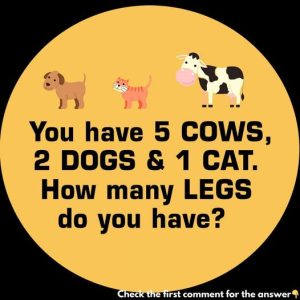Outsmarting Deceptive Questions: The Simple Answer Behind a Tricky Riddle
In the world of puzzles and riddles, some questions are crafted to steer your thinking in the wrong direction. One such example is the seemingly simple question: “You have 5 cows, 2 dogs, and 1 cat. How many legs do you have?” On the surface, it appears to be a basic math problem, but it’s actually a clever trick designed to mislead. Let’s break down this riddle and explore how deceptive questions work.

Understanding the Trick: A Breakdown of the Riddle
When faced with this question, your first instinct might be to calculate the total number of legs for the cows, dogs, and cat mentioned. That’s where the trap lies. The question provides specific information about the animals, causing you to shift focus away from what’s really being asked—you.
To demonstrate this, let’s calculate the legs:
- Cows: Each cow has four legs, so 5 cows give you 5×4=20 legs.
- Dogs: Each dog also has four legs, so 2 dogs give you 2×4=8 legs.
- Cats: One cat has four legs, adding 1×4=4 legs.
Add these up, and you get 20+8+4=32 legs. But here’s the twist—the question isn’t about the animals’ legs. It’s asking, “How many legs do YOU have?”
The Real Answer: Two Legs
The correct answer is much simpler than you think. As a human, you have two legs. The mention of cows, dogs, and a cat is a distraction designed to throw you off. It’s a classic example of a deceptive question that tricks you into focusing on irrelevant details.
This riddle shows how easily we can be misled by seemingly relevant information. Humans tend to focus on the most immediate details, especially when a question involves numbers or logic. This natural tendency often leads us to overthink and miss the simple, correct answer.
Why Deceptive Questions Work
Deceptive questions like this are effective because they play on our cognitive biases. When presented with a list of animals and a question about legs, our brains automatically link the two, prompting us to count the legs of the animals instead of thinking about the actual question. This is a perfect example of how context can influence our thought process and steer us away from the right answer.
Common Cognitive Biases at Play
Several cognitive biases make us fall for these tricks:
- Anchoring Bias: This happens when we rely too much on the first piece of information we see (in this case, the animals and their legs) and ignore other possibilities.
- Confirmation Bias: Once we start counting the animals’ legs, we tend to stick with that approach and ignore any clues suggesting otherwise.
- Overthinking: We often overcomplicate simple questions, expecting them to be more difficult than they are, which blinds us to the easy answer.
How to Outsmart Deceptive Questions
To avoid being fooled by questions like this, it’s important to develop strategies for handling tricky information:
- Read the question carefully and focus on what’s really being asked.
- Ignore unnecessary details that might be designed to distract you.
- Simplify the problem by breaking it down into its most basic components.
- Practice critical thinking with puzzles and brain games to train your mind to spot tricks.
Mastering Deceptive Questions
The riddle about how many legs you have is a great example of how easily we can be misled by irrelevant details. The key to solving these riddles is to focus on the true question and avoid distractions. By understanding the psychology behind deceptive questions, you can sharpen your thinking and become less vulnerable to such tricks.





